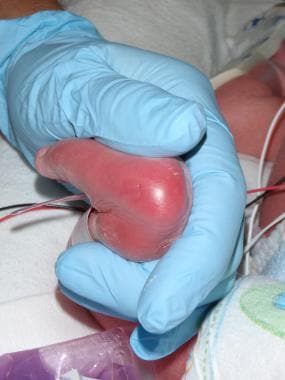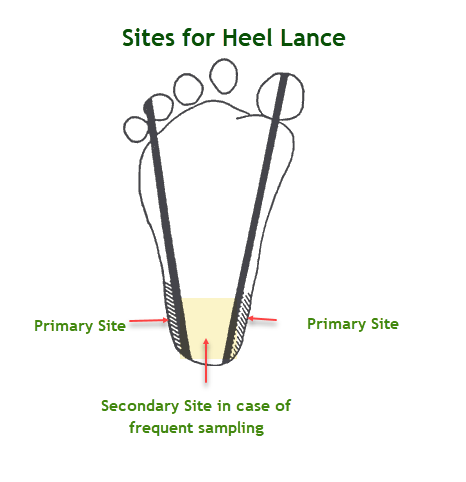
Accuracy of results depends on proper heelstick and sample collection technique. Have parent hold child during this time.

Do not squeeze the fingertoeheelearlobe too have been reported to obtain sufficient blood without squeezing the heel.
Infant heel stick procedure. The heel-stick method for drawing capillary blood is the most common way to draw newborns blood. It is used to collect blood for newborn screening tests usually before the baby leaves the hospital. Heel sticks are the most commonly performed invasive procedure in.
Heelstick procedure step-by-step Heel sticks are appropriate for infants less than six months of age or less than 20 pounds. Warm the site using an appropriate warming device for three to five minutes. Capillary heel sticks are done on babies 6 months of age or less.
If the baby walks it is too old for a capillary heel stick and a venipuncture is to be done. Capillary sticks may also be on fingers when no veins are accessible and the quantity of blood required for testing can be obtained by capillary stick. Guide to capillary heelstick blood sampling in infants.
Capillary blood sampling is an essential method of blood collection performed by nurses of all skill levels to obtain samples for routine laboratory tests in neonates. Accuracy of results depends on proper heelstick and sample collection technique. Recent advances including development of.
Obtaining blood via heel stick. Adequate quantities of serum may be obtained via heel stick in almost any neonate. If done properly hemolysis should not be a significant problem.
The skins blood supply is located at the junction of the dermis and subcutaneous tissue 035 to 16 mm from the skin surface. Position the infant with the head slightly elevated. Warm the heel from which blood is to be obtained.
A commercial heel warmer may be used. Cleanse the heel with alcohol prep then dry with a sterile 22 as alcohol can influence test results. PROCEDURE Gather Equipment 1.
Chlorhexidine swab 2 chlorhexidine gluconate with 70 isopropyl alcohol swab 4. Heel warming pack and plastic wrap 5. Sterile lancet Pink genie for all infants 6.
Pacifier andor blanket for developmental swaddling Procedure Notes 1. Start studying Infant Heal Punctures Heel Stick Procedure. Learn vocabulary terms and more with flashcards games and other study tools.
Capillary blood sampling is an essential method of blood collection performed by nurses of all skill levels to obtain samples for routine laboratory tests in neonates. Accuracy of results depends on proper heelstick and sample collection technique. Recent advances including development of devices designed specifically for heelstick capillary blood.
Choice of procedure and site. The choice of site and procedure venous site finger-prick or heel-prick also referred to as capillary sampling or skin puncture will depend on the volume of blood needed for the procedure and the type of laboratory test to be done. Venepuncture is the method of choice for blood sampling in term neonates 62 63.
However it requires an. Elevate puncture site during procedure as clinically indicated. Do not squeeze the fingertoeheelearlobe too have been reported to obtain sufficient blood without squeezing the heel.
Also 26 times less punctures which resulted in shorter collection times. Unformatted text preview. Nursing Skill Gurjashan Grewal STUDENT NAME_____ Stick SKILL NAME__Heel _____ REVIEW MODULE CHAPTER_____ Description of Skill Heel stick is a simple procedure in which a newborn babys heel is pricked and then a small amount of the blood is collected.
Capillary sampling from a finger heel or rarely an ear lobe may be performed on patients of any age for specific tests that require small quantities of blood. However because the procedure is commonly used in paediatric patients Sections 711 and 712 focus particularly on paediatric capillary sampling. How is the newborn heel stick test performed.
The heel stick test is done within a few days of birth. Ideally the test should be performed during the first 48-96 hours of life to ensure an accurate screening. The test is generally done right before baby is discharged.
The babys heel will be pricked and a few drops of blood will be taken and placed it on a filter paper. The sample is called a blood spot The dried. Ensure size of lancet chosen is appropriate for patient.
Position the heel lower than the torso and grasp the foot firmly without flexing the ankle severely. This grasp prevents movement during the heelstick and controls milking of the foot. Cleanse heel with antiseptic and dry with sterile gauze after 30 seconds.
Collect equipment needed including cotton wool capillary tube andor blood bottle appropriate depth incision device clean tray and a sharps bin. Wash hands as per hand washing guidelines and put on non-sterile gloves. Ensure the baby is in a safe and comfortable position offer the baby oral sucrose if.
Heel stick is the most common and minimally invasive method to draw capillary blood from an infant for medical testing. Capillaries are tiny blood vessels which carry blood to the tissues and connect arteries to the veins. A sharp device known as a lancet is.
Procedure for Heelstick. Prewarm the infants heel with a warm wet towel or other warming device at a temperature no higher than 42 C for three to five minutes if the temperature used to warm the heel is too high you risk burning the baby. This is essential for capillary blood gas sample collection and it greatly increases the blood flow for collection of other specimens.
Infant Heal Punctures Heel Stick Procedure 18 Terms. Capillary Puncture Steps 18 Terms. Venipuncture using a vacutainer system.
Dermal Puncture Steps 21 Terms. OTHER SETS BY THIS CREATOR. Pre-warm the infants foot with a heel warmer.
If needed place a heel warmer around baby heel and one around the calf. Wrap in diaper or blanket for 5-10 minutes if necessary. Have parent hold child during this time.
Reassure the parents that you will be as gentle as possible.